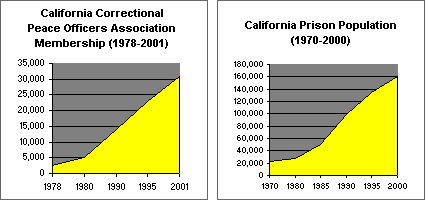The prison guards' organization grew dramatically over the past two decades, right alongside California's prison population. While the number of inmates soared from 28,000 in 1980 to 160,000 in 2000, the union's membership swelled from fewer than 5,000 to 31,000. Their $59 a month dues payments give the union a $22 million annual budget.
| | 
While the state's prison population ballooned over the last two decades, the union's membership grew more than ten fold—to 31,000. Sources: CCPOA and the California Department of Justice
|
In 1980, the union had a staff of four. Today, Union Vice President Lance Corcoran, a former guard and the union's chief spokesman, is one of 90 employees. "We have two in-house, full-time lobbyists," Corcoran says while giving a tour of the two-story union headquarters in west Sacramento. "And, depending on what's happening, we employ anywhere from three to sometimes as many as six contract lobbyists." The union has emerged as one of California's biggest political donors. Its Political Action Committees have doled out almost ten million dollars since 1998.
The CCPOA uses some of its clout on bread-and-butter issues. The average California guard now earns about $50,000 dollars a year - almost twice the national average for corrections officers. Under a new contract to take effect in 2003, California guards will earn up to $73,000. That contract was pushed through the state senate by Majority Leader John Burton and signed by Governor Gray Davis. The CCPOA gave Burton more than $400,000 for his last campaign. It spent more than $2 million supporting Davis's election in 1998.

CCPOA's two-story headquarters in west Sacramento. Photo: John Biewen | |
Still, Corcoran doesn't like hearing the union described as powerful. "'Powerful' I think has sort of a negative connotation that we abuse that power in some ways," he says. "I think a more appropriate term would be 'successful.' We have successfully moved our agenda by supporting candidates that are willing to listen to our issues."
Those issues include not only wages and vacation time and training, but also tough-on-crime policies.
Defending Three Strikes
At the state Assembly hearing, the guard union's chief lobbyist, Jeff Thompson (speaking "on behalf of Crime Victims United of California, also with the CCPOA"), argues against any softening of Three Strikes. The law has helped stabilize the prison population, he says, "as the true habitual criminals have been incarcerated and off the street."
California's crime rate has dropped by 40% since 1994, a fact the union attributes largely to the deterrent effect of the Three Strikes law. The law's critics point out that crime dropped about as much in New York State (41%), Massachusetts (33%) and Washington D.C. (31%), none of which have adopted Three Strikes.
Thousands of union jobs are at stake in the battle over Three Strikes. If the law goes unchanged, a dozen years from now California prisons will hold an estimated fifteen thousand aging third strikers, most of whom would have been released years earlier without the law.
In the hallway after the hearing, lobbyist Thompson huddles with members of victims' groups. He sends them to lobby Assembly members against the Three Strikes reform bill. "Go to the main bank of elevators across from the Governor's office and there's a roster," he says. "Go get 'em."
Next: Reform on the Ballot

